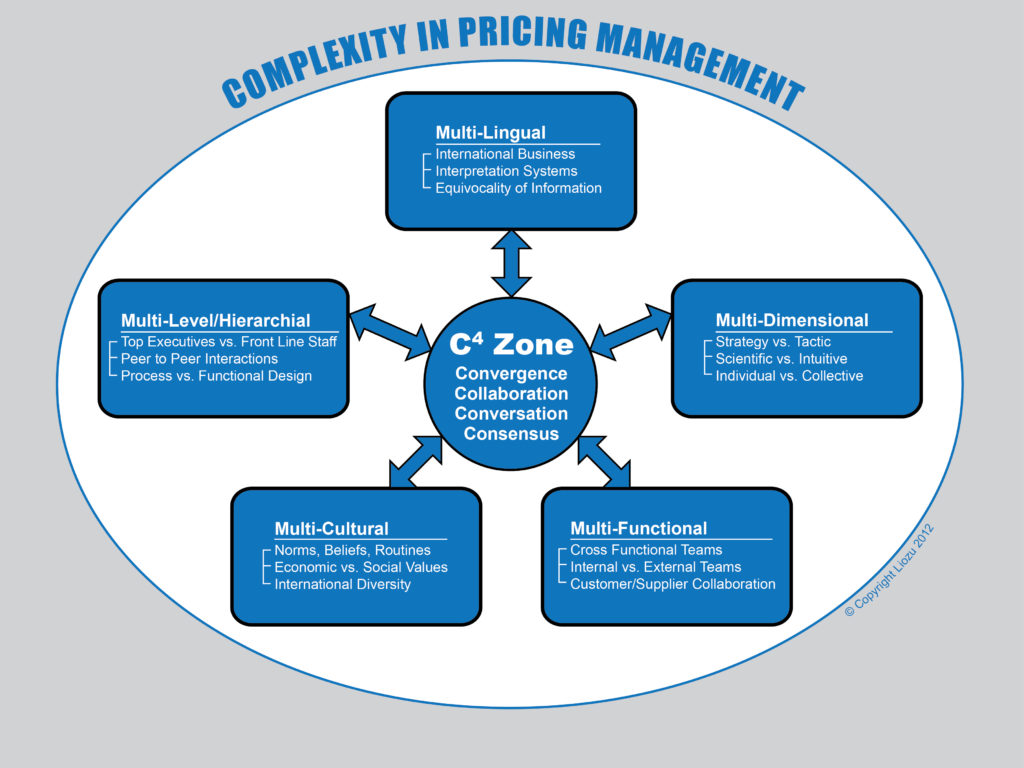
Pricing is complex. Pricing leaders have difficult jobs. In this article, Stephan M. Liozu, Ph.D, Founder & Disruptor, highlights different types of business complexity and provides tips for managing complexity to transform it into a competitive advantage.
Pricing is often the most complex discipline in an organization. I’d put pricing in the same complexity category as supply chain management or analytics. Why is that? When managed well, pricing is a dedicated function that intersects with multiple other functions. One can argue that pricing touches all departments and impacts some of the most critical organizational processes.
In order to achieve or maintain pricing excellence all functions must work together. And I really mean all functions! From supply chain, to sales, marketing, accounting, and customer success, teams need to converge, communicate, and collaborate in order to sustain high performance levels. This is what I call the C4 zone in the visual below. In this visual, I’ve mapped the level of complexity that pricing implies. When deployed globally, pricing is multi-functional, multi-cultural, multi-lingual, multi-dimensional, and multi-hierarchical. Put this in the perspective of a global pricing transformation, and you get the picture. It can be complete chaos if not managed by organizational experts.

Complexity is Compounding
Some of you may say that I am stating the obvious. I agree. But from time to time, it is beneficial to revisit this topic and not fall into the complexity trap. What I mean by that is that while pricing is complex internally, customers do not care about our complexity and are asking for simple pricing strategies and models to integrate.
There is no doubt that the last five years have made doing business very complicated. Most organizations have faced very challenging times and have made rapid changes to adapt. Right now, the business world is changing at the speed of light. The digitization and globalization of business has transformed how business is conducted, how interactions are managed, and how business strategies are deployed locally and around the world. The end result of these mega-trends is increased competition, more sophisticated competitors and customers, and the emergence of complex problems.
Are you ready for to face more complexity? How good are you at managing complexity? Can you leverage this complexity to create differentiation and competitive advantage?
Types of Business Complexity
Complexity can be good and bad at the same time. There are four types of complexity in business, and it is important to break them down to be able to understand them and eventually address them:
1. Imposed Complexity
Imposed Complexity comes from regulations and mandatory compliance guidelines both at industry and governmental levels. It is typically not controllable or manageable, so it is best to prepare for it and find a way to minimize its impact on the business.
2. Inherent Complexity
Inherent complexity is structural complexity which is inherited and well rooted in the business. It can be addressed by making deep structural changes that might be painful but beneficial to the future of the business.
3. Designed Complexity
Designed complexity is based on purposeful design of strategies and programs to support the long-term vision for the firm. This complexity is based on managerial choices aimed at creating competitive advantages.
4. Unnecessary Complexity
Unnecessary complexity is the result of legacy management design and structure that might not have been updated, eliminated, or refreshed. It is unnecessary because it brings no value to the business, and it solely exists because no one is paying attention to it.
How to Manage Pricing Complexity in Your Business
Pricing is not immune to increasing complexity. As a pricing leader facing resource constraints, I highly recommend you start paying attention to these four types of complexity. My advice is to assemble a process and team to review complexity, and engage in the design of strategies that will leverage complexity to bring differentiation to the market. Here are some quick tips on how to do this:
1. Design positive complexity to create differentiation.
That should be the main focus on your critical actions and priorities. Can you create complexity that differentiates your pricing strategies, your delivery of pricing to customers, your innovation in pricing, and your digital pricing tactics without overwhelming your customers? Can you create unique value selling propositions based on unique internal designs and systems?
2. Quickly kill unnecessary complexity while reassigning resources and skills.
Unnecessary complexity might be inherited from legacy management designs or decisions. They might bring zero business value and thus, need to be removed . Examples of unnecessary complexity include the thousands of pricing reports that are generated and never read, the endless pricing discussions that bring no value, the antiquated inter-company pricing mechanisms, and the analysis-paralysis mindset that delays business velocity. Be decisive and free up resources for something else.
3. Transform internal complexity into simple value propositions.
Remember, internal complexity has to be transformed into simple offerings for customers. If, for example, you decide to propose structured pricing customers, do it by absorbing complexity and by offering transparency pricing and clear options on where to buy. Customers cannot shop around multiple places and find different product and pricing levels. Remember to keep it simple, stupid (KISS principle)!
4. Focus on pockets of value-creating complexity for customers.
It is all about value. Complex designs have to bring value to customers. If they don’t, they should not be implemented. As a leader, please make sure value is real and can be monetized through pricing. You might have the best supply chain management process, but will customers see the value in it and be willing to pay for some of the services?
5. Assign your best talent to manage complex problems and initiatives.
The world is becoming increasingly complex. Solve complex pricing problems with the best thinkers and executors in your business. Complex problems need mindful problem solving.
I will say it one more time. Your customers do not care about your complexity. They do not want to be on the receiving end of it. They have options and will clearly move on to another vendor. Satisfaction with a vendor’s pricing is often a key differentiator for customers. Is it simple to understand? Can I get information in real time? Are your sellers equipped with the latest and greatest pricing data? Can I get quotes in minutes instead of days? Investing in the right pricing technology can help manage complexity for simplicity. But do not forget the mindset as well!
Join Stephan Liozu at Vendavo’s 2022 Growth + Profitability Summit in Denver
Stephan Liozu will be sharing his unique perspective on managing business complexity and transforming it into a competitive advantage at this year’s Growth+Profitability Summit in Denver. Don’t miss your chance to meet Stephan and other pricing experts in person this September!
Hear from pricing experts like Stephan Liozu at Vendavo’s Growth + Profitability Summit. Register Here.
